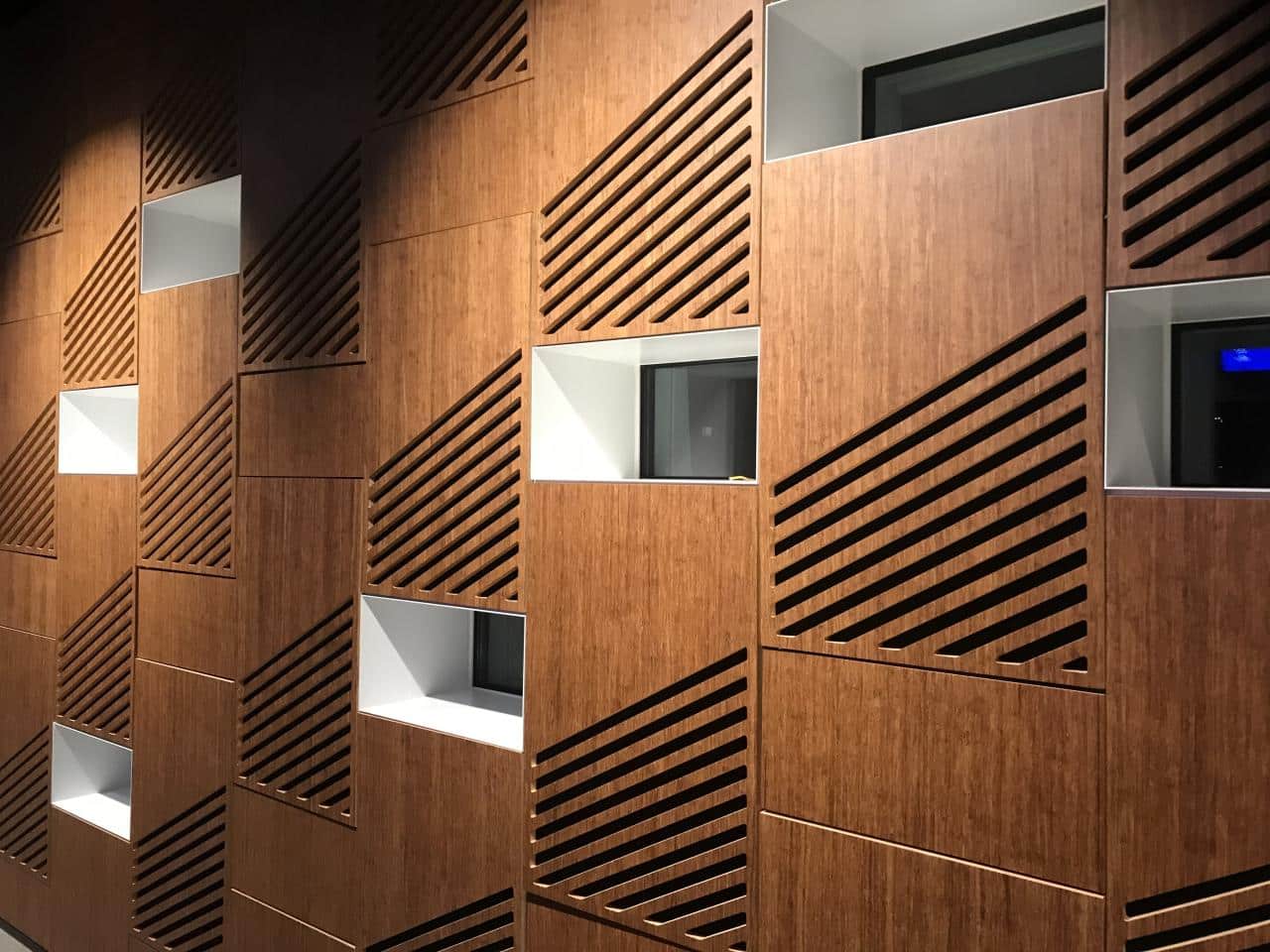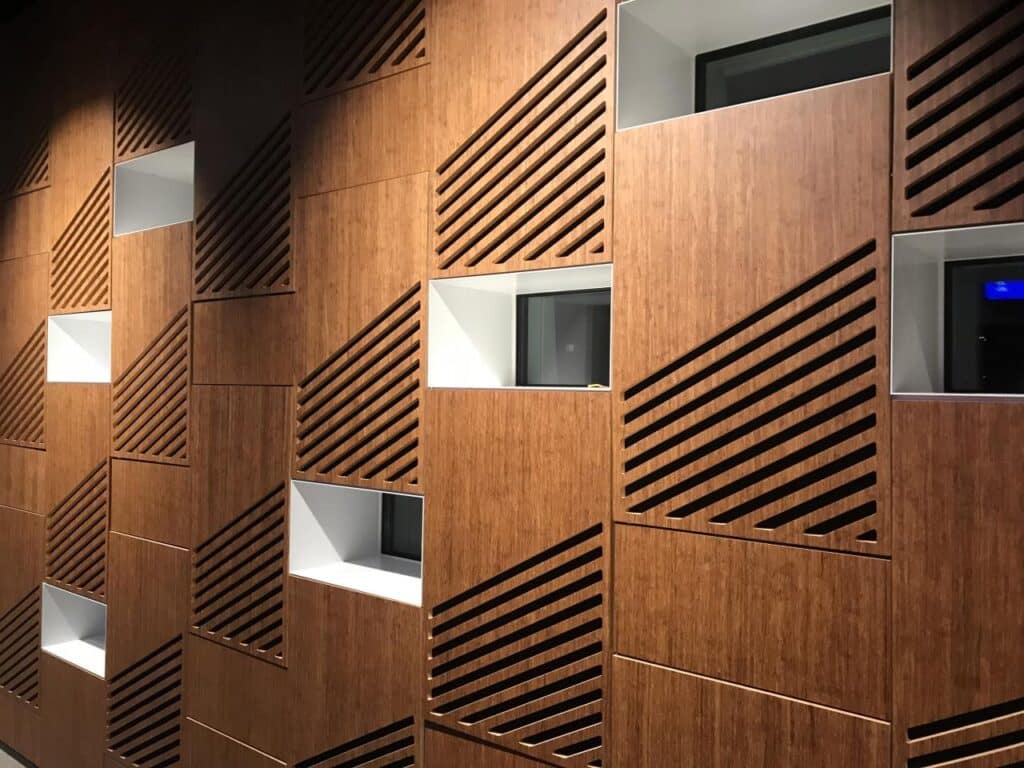Acoustic Wood Panels 2024: Stepping into a room with acoustic wood panels is like stepping into a symphony of sound and design. These panels are more than just a decorative element; they are the architects of a captivating acoustic experience, transforming spaces into havens of serenity or vibrant stages for sound.
Acoustic wood panels have emerged as a leading solution for soundproofing, noise reduction, and enhancing the overall acoustics of a space. From residential living rooms to bustling office environments, these panels offer a harmonious blend of functionality and aesthetics.
They are crafted from natural materials, offering a warm, inviting feel that complements a wide range of design styles.
Introduction to Acoustic Wood Panels
Acoustic wood panels have become increasingly popular in 2024 as a stylish and effective solution for improving sound quality and reducing noise in a wide range of spaces. From homes and offices to studios and auditoriums, these panels offer a natural and elegant way to enhance acoustics and create a more comfortable and productive environment.
Purpose and Benefits of Acoustic Wood Panels
Acoustic wood panels address a crucial need in modern spaces, where noise pollution and poor acoustics can negatively impact productivity, concentration, and overall well-being. They effectively absorb sound energy, reducing reverberation and echo, creating a more balanced and pleasant listening experience.
Compared to other soundproofing materials, acoustic wood panels offer several key advantages, including:
- Aesthetic Appeal:Natural wood grain patterns and finishes provide a warm and inviting aesthetic that complements various interior design styles.
- Sustainability:Wood is a renewable and sustainable material, making acoustic wood panels an environmentally conscious choice.
- Durability:Wood panels are robust and long-lasting, offering excellent value for money.
- Versatility:Acoustic wood panels come in various sizes, shapes, and designs, allowing for customization to suit specific needs and aesthetics.
Examples of specific applications where acoustic wood panels are particularly effective include:
- Home theaters:Reducing echo and reverberation for a more immersive cinematic experience.
- Recording studios:Creating a controlled acoustic environment for optimal sound recording and mixing.
- Restaurants and cafes:Enhancing ambiance and reducing noise levels for a more comfortable dining experience.
- Office spaces:Improving sound privacy and reducing distractions for increased productivity.
- Schools and classrooms:Enhancing speech intelligibility and creating a more conducive learning environment.
History of Acoustic Wood Panels
The concept of using wood for sound absorption dates back centuries, with early examples found in traditional wooden structures. However, the development of modern acoustic wood panels emerged in the 20th century, driven by advancements in sound engineering and the growing need for effective soundproofing solutions.
- Early Applications:Initial applications of acoustic wood panels focused primarily on industrial settings, such as factories and workshops, to reduce noise levels and improve worker safety.
- Evolution of Materials and Design:Over time, advancements in wood processing techniques, along with the introduction of new materials like fiberglass and mineral wool, led to the development of more sophisticated and aesthetically pleasing acoustic wood panels.
- Innovation and Functionality:Key milestones in the history of acoustic wood panels include the development of perforation techniques, the use of varying thicknesses for targeted sound absorption, and the incorporation of surface treatments to enhance aesthetic appeal and acoustic performance.
Key Features and Characteristics of Acoustic Wood Panels
Acoustic wood panels are designed to absorb sound energy and reduce noise levels through a combination of material properties and design features.
- Types of Wood:Commonly used wood species include oak, maple, walnut, and cherry, each offering unique grain patterns and acoustic properties.
- Acoustic Wood Panel Designs:
- Plank Panels:Rectangular panels with a flat surface, often used for wall and ceiling applications.
- Slat Panels:Panels with vertical or horizontal slats, offering a visually appealing and acoustically effective solution.
- Cloud Panels:Suspended panels that provide sound absorption and a modern aesthetic.
- Baffle Panels:Panels with a curved or angled design, used for sound diffusion and absorption.
- Role of Perforation, Thickness, and Surface Treatment:
- Perforation:Holes or slots in the panel surface increase the surface area available for sound absorption.
- Thickness:Thicker panels generally provide better sound absorption, particularly at lower frequencies.
- Surface Treatment:Finishes like paint, stain, or varnish can enhance aesthetics and provide additional protection against moisture and wear.
- Sound Absorption and Noise Reduction:Acoustic wood panels achieve sound absorption by converting sound energy into heat through friction and damping. The panel’s design and material properties determine its effectiveness at absorbing different frequencies.
Types of Acoustic Wood Panels
Acoustic wood panels are a popular choice for soundproofing and improving the acoustics of a space. They are aesthetically pleasing, environmentally friendly, and offer excellent sound absorption properties. Acoustic wood panels are available in a variety of styles and materials, each with its unique acoustic performance and visual appeal.
Classifications of Acoustic Wood Panels
Acoustic wood panels can be broadly classified into three main types:
- Standard Wood Panels:These are the most basic type of acoustic wood panels and are made from solid wood. They are typically used for sound absorption in commercial and residential spaces.
- Perforated Wood Panels:These panels have holes or perforations that increase their sound absorption capabilities. The perforations allow sound waves to penetrate the panel and be absorbed by the material behind it.
- Wood Veneer Panels:These panels are made from thin sheets of wood veneer applied to a backing material, such as plywood or MDF. They offer a more affordable option compared to solid wood panels and provide a wide range of wood species and finishes.
Acoustic Performance of Different Wood Panel Types
The acoustic performance of acoustic wood panels is measured by their Noise Reduction Coefficient (NRC) rating. The NRC rating is a single-number rating that represents the average sound absorption coefficient of a material at frequencies between 250 Hz and 2000 Hz.
- Standard Wood Panels:These panels typically have an NRC rating of 0.15 to 0.30, which indicates moderate sound absorption.
- Perforated Wood Panels:Perforated wood panels offer higher sound absorption than standard wood panels, with an NRC rating ranging from 0.40 to 0.70. The size and spacing of the perforations play a significant role in their acoustic performance.
- Wood Veneer Panels:Wood veneer panels typically have an NRC rating similar to standard wood panels, ranging from 0.15 to 0.30. However, the NRC rating can vary depending on the thickness of the veneer and the backing material used.
Design Aesthetics and Visual Appeal
Acoustic wood panels are available in a variety of wood species, finishes, and designs, allowing for a wide range of aesthetic choices.
- Wood Species:Popular wood species for acoustic panels include oak, maple, walnut, cherry, and pine. Each species offers a unique grain pattern and color, contributing to the overall visual appeal of the panels.
- Finishes:Acoustic wood panels can be finished with a variety of stains, paints, and varnishes to enhance their natural beauty or create a specific aesthetic. The finish can also affect the sound absorption properties of the panels.
- Designs:Acoustic wood panels can be customized with various designs, such as geometric patterns, grooves, and textures. These designs can add visual interest and enhance the overall acoustic performance of the panels.
3. Applications of Acoustic Wood Panels
Acoustic wood panels offer a versatile and aesthetically pleasing solution for managing sound in a wide range of environments. Their ability to absorb and diffuse sound waves makes them an ideal choice for enhancing the acoustics of homes, businesses, and industrial spaces.
Residential Applications
Acoustic wood panels can significantly improve the sound quality and overall comfort of your home.
- Home Theaters:By strategically installing acoustic wood panels on walls and ceilings, you can create a more immersive and enjoyable home theater experience. The panels absorb unwanted sound reflections, reducing echoes and reverberation, resulting in clearer dialogue and a more balanced soundstage.This helps to create a more realistic and engaging movie-watching experience.
- Bedrooms:Acoustic wood panels can be used to create a more peaceful and restful bedroom environment. They effectively reduce noise from outside sources, such as traffic, neighbors, or even household appliances. By minimizing noise distractions, you can enjoy a better night’s sleep and wake up feeling refreshed.
- Living Rooms:Acoustic wood panels can transform your living room into a more comfortable and acoustically balanced space. They absorb excess sound, reducing reverberation and echoes, which can make conversations easier and music sound clearer. The panels can also help to create a more intimate and inviting atmosphere in your living room.
Acoustic Consultants
Acoustic Pods
Acoustic Products
Acoustic Solution
Slalom Acoustic
Acoustic Box
Silent Piano
Acoustic Wood Panels
Suspended Acoustic Ceiling
Faith Acoustic Guitar
Acoustic Guitar Sound
Commercial Applications
Acoustic wood panels are widely used in commercial settings to create more functional and enjoyable spaces.
- Restaurants:Acoustic wood panels can help to create a more intimate and enjoyable dining experience in restaurants. They absorb unwanted noise, reducing reverberation and making conversations easier. This can help to create a more relaxed and comfortable atmosphere for diners.
- Offices:Acoustic wood panels are essential for improving productivity and reducing distractions in office spaces. They absorb sound, creating a quieter and more focused work environment. This can help to improve employee morale and productivity.
- Retail Stores:Acoustic wood panels can create a more inviting and comfortable shopping experience in retail stores. They can help to reduce noise levels, making it easier for customers to hear product information and engage with staff. The panels can also be used to create specific sound zones within the store, highlighting certain products or areas.
Industrial Applications
Acoustic wood panels can be used to improve noise control and worker safety in industrial settings.
- Manufacturing Facilities:Acoustic wood panels can be used to reduce noise levels in manufacturing facilities, creating a safer and more comfortable work environment for employees. The panels can be installed on walls, ceilings, and machinery to absorb noise and reduce the overall noise level.
- Warehouses:Acoustic wood panels can be used to create a more controlled and efficient warehouse environment. They can help to reduce noise levels, making it easier for workers to communicate and focus on their tasks. The panels can also be used to create specific sound zones within the warehouse, such as areas for storage or shipping.
- Construction Sites:Acoustic wood panels can be used to reduce noise pollution and improve community relations on construction sites. The panels can be installed on temporary barriers or fences to absorb noise and prevent it from spreading to surrounding areas.
Specific Project Examples
Here are some real-world examples of projects where acoustic wood panels have been successfully implemented:
- Home Theater:A homeowner in Seattle, Washington, used acoustic wood panels to transform their basement into a state-of-the-art home theater. The panels were installed on the walls and ceiling, absorbing unwanted sound reflections and creating a more immersive and enjoyable movie-watching experience.
- Office:A large corporation in New York City installed acoustic wood panels in their open-plan office space to improve employee productivity and reduce distractions. The panels absorbed sound, creating a quieter and more focused work environment.
- Restaurant:A popular restaurant in Chicago used acoustic wood panels to create a more intimate and enjoyable dining experience. The panels absorbed unwanted noise, reducing reverberation and making conversations easier.
Sound Quality Enhancement
Acoustic wood panels are highly effective in improving sound quality in various spaces. This is due to the unique acoustical properties of wood, which contribute to sound absorption and diffusion.
- Sound Absorption:Wood has a natural ability to absorb sound waves, particularly at mid-range frequencies. This is because the porous structure of wood allows sound waves to penetrate its surface and be converted into heat energy, reducing the intensity of sound reflections.
- Sound Diffusion:The surface of wood can be textured or shaped to create irregular patterns that scatter sound waves in multiple directions. This helps to prevent echoes and reverberation, creating a more balanced and pleasant sound environment.
Different types of wood panels can be used to achieve different acoustical effects:
- High-Density Wood Panels:These panels are designed for maximum sound absorption and are often used in spaces where noise control is a priority, such as recording studios or industrial settings.
- Perforated Wood Panels:These panels feature holes or perforations that allow sound waves to penetrate the surface and be absorbed by the material behind the panel. They offer a good balance of sound absorption and aesthetic appeal.
- Diffuser Panels:These panels are designed to scatter sound waves in multiple directions, helping to reduce echoes and create a more balanced sound environment. They are often used in concert halls, theaters, and other spaces where sound clarity is important.
4. Installation and Design Considerations
Installing acoustic wood panels is a crucial step in achieving the desired acoustic and aesthetic outcomes for a space. Proper installation ensures optimal sound absorption, reflection, and diffusion, while also creating a visually appealing and cohesive interior design.
4.1 Installation Process
This section Artikels the step-by-step process for installing acoustic wood panels, covering essential tools, surface preparation, attachment methods, cutting techniques, and fastener considerations.
- Preparing the Wall Surface:Before installation, the wall surface must be thoroughly cleaned to remove dust, dirt, and debris. Any imperfections, such as cracks or holes, should be patched and allowed to dry completely. Priming the wall surface enhances adhesion and creates a smooth, uniform base for the panels.
- Attachment Methods:Acoustic wood panels can be attached to walls using various methods, each with its own advantages and considerations:
- Adhesive:Construction adhesive is a convenient option for attaching panels, especially for smaller sizes. Ensure the adhesive is specifically designed for wood and has strong bonding properties.
- Clips:Clips provide a secure and discreet attachment method, often used for larger panels. They are typically installed to the wall using screws or nails, and the panels are then slotted into the clips.
- Furring Strips:Furring strips create a gap between the wall and the panels, allowing for better sound isolation and ventilation. They are attached to the wall using screws or nails, and the panels are then fastened to the strips.
- Cutting and Trimming:Acoustic wood panels can be cut to fit specific wall dimensions and corners using a saw. Measure carefully and mark the cutting lines before making any cuts. Ensure the cuts are clean and precise for a seamless installation.
- Essential Tools:The following tools are essential for installing acoustic wood panels:
- Measuring tape
- Level
- Saw (e.g., circular saw, jigsaw)
- Drill
- Fasteners (e.g., screws, nails, clips)
- Fastener Considerations:Using the appropriate fasteners and securing them properly is crucial for long-term durability. The type of fastener should be compatible with the wall material and the panel thickness. Overtightening fasteners can damage the panels, while loose fasteners can lead to instability.
4.2 Importance of Proper Installation
Proper installation plays a vital role in achieving the desired acoustic performance of wood panels. It influences factors like sound absorption, reflection, and diffusion.
- Sound Absorption:Properly installed acoustic wood panels effectively absorb sound waves, reducing reverberation and improving sound clarity. Gaps or uneven surfaces between panels can create sound leaks, compromising the overall sound absorption capabilities.
- Sound Reflection:The way sound waves reflect off surfaces influences the acoustic characteristics of a space. Properly installed panels create a balanced reflection pattern, ensuring even sound distribution. Improper installation can lead to uneven reflection, resulting in sound distortion and hot spots.
- Sound Diffusion:Sound diffusion refers to the scattering of sound waves to prevent echoes and improve sound clarity. Panels installed with consistent spacing and proper alignment contribute to effective sound diffusion.
4.3 Design Considerations
Incorporating acoustic wood panels into interior design requires a balance between aesthetics and acoustics. Different panel shapes, sizes, and finishes can influence the visual and acoustic impact of a space.
- Panel Shapes and Sizes:Rectangular panels are a classic choice, offering versatility in arrangement and pattern. Square panels create a more modern aesthetic, while irregular shapes add visual interest. The size of the panels can influence the acoustic performance. Larger panels are generally more effective at absorbing low-frequency sounds, while smaller panels are better at absorbing high-frequency sounds.
- Panel Finishes:Acoustic wood panels come in a variety of finishes, including natural wood, painted, stained, and textured. The finish can impact the visual appeal and acoustic properties of the panels. For example, a natural wood finish can create a warm and inviting ambiance, while a textured finish can help to diffuse sound waves.
- Panel Arrangements and Patterns:The arrangement and pattern of the panels can significantly influence the visual and acoustic impact of a space. For example, a staggered pattern can create a sense of depth and movement, while a grid pattern can create a more structured and organized look.The arrangement of the panels can also influence the sound absorption and diffusion properties of the space.
- Applications:Acoustic wood panels can be used to enhance the acoustics of various spaces, including:
- Home Theaters:Panels can be used to reduce reverberation and improve sound clarity, creating a more immersive and enjoyable viewing experience.
- Recording Studios:Panels are essential for controlling sound reflections and creating a more acoustically balanced recording environment.
- Conference Rooms:Panels can help to reduce noise levels and improve speech intelligibility, making it easier for people to communicate and collaborate.
5. Acoustic Performance and Testing
Understanding the acoustic performance of wood panels is crucial for their effective application in various settings. This section explores the methods used to measure the sound absorption and transmission properties of wood panels, delves into the key acoustic properties that influence their performance, and examines real-world data and test results.
5.1. Measurement Methods
To quantify the acoustic performance of wood panels, specific instruments and techniques are employed to measure their sound absorption and transmission characteristics. These methods provide valuable insights into how effectively wood panels can reduce noise levels and improve sound quality in different environments.
- Sound Absorption Coefficient:The sound absorption coefficient (α) quantifies the amount of sound energy absorbed by a material. It is measured as a fraction between 0 and 1, where 0 represents no absorption and 1 represents complete absorption. The most common method for measuring the sound absorption coefficient is the reverberation chamber test.
- Reverberation Chamber Test:This test involves placing a sample of the wood panel in a specially designed reverberation chamber, which is a room with carefully controlled acoustic properties. A sound source is introduced into the chamber, and the time it takes for the sound to decay is measured.By analyzing the decay time, the sound absorption coefficient of the wood panel can be calculated.
- Sound Transmission Loss:The sound transmission loss (TL) measures the effectiveness of a material in blocking sound transmission through it. It is expressed in decibels (dB) and represents the difference in sound pressure levels between the source and the receiving side of the material.The most common method for measuring sound transmission loss is the laboratory test setup.
- Laboratory Test Setup:This method involves placing a sample of the wood panel in a test chamber with a sound source on one side and a microphone on the other. The sound pressure levels on both sides of the panel are measured, and the difference between them represents the sound transmission loss.
- Advantages and Limitations:Each measurement method has its advantages and limitations. The reverberation chamber test is widely accepted and provides accurate results, but it requires specialized equipment and facilities. The laboratory test setup is more accessible and cost-effective but may not accurately represent real-world conditions.
5.2. Key Acoustic Properties, Acoustic Wood Panels 2024
The acoustic performance of wood panels is influenced by several key properties, including porosity, density, thickness, and surface treatments. Understanding these properties is essential for selecting the most appropriate wood panel type for a given application.
- Porosity:The porosity of a wood panel refers to the amount of air space within the material. Higher porosity generally leads to greater sound absorption, as the air spaces act as traps for sound waves.
- Density:The density of a wood panel is a measure of its mass per unit volume. Higher density generally results in greater sound transmission loss, as the material is more resistant to sound waves passing through it.
- Thickness:The thickness of a wood panel also plays a significant role in its acoustic performance. Thicker panels generally provide greater sound absorption and transmission loss.
- Surface Treatments and Finishes:Surface treatments and finishes can significantly affect the acoustic properties of wood panels. For example, adding a porous coating can increase sound absorption, while a smooth finish can reduce sound absorption.
- Noise Reduction:Noise reduction refers to the reduction in sound levels achieved by using sound-absorbing materials. The sound transmission loss of wood panels directly contributes to noise reduction, as it determines how effectively the panels block sound transmission through them.
5.3. Performance Data and Test Results
Extensive testing has been conducted to quantify the acoustic performance of various wood panel types. The results provide valuable insights into the sound absorption and transmission characteristics of these materials, enabling informed selection for specific applications.
- Sound Absorption Coefficients:The following table summarizes the sound absorption coefficients of different wood panel types across various frequency ranges:
| Panel Type | Frequency Range (Hz) | Sound Absorption Coefficient (α) |
|---|---|---|
| Plywood | 125-4000 | 0.15-0.60 |
| MDF | 125-4000 | 0.20-0.75 |
| Solid Wood | 125-4000 | 0.10-0.50 |
- Sound Transmission Loss:The following graph illustrates the sound transmission loss of wood panels with different thicknesses and densities:
[Image Description: A graph with sound transmission loss (TL) on the y-axis and frequency on the x-axis. Multiple lines represent different wood panel thicknesses and densities. Thicker and denser panels exhibit higher TL values, indicating greater sound blocking ability.]
- Case Study:A concert hall was designed using wood panels for its acoustic treatment. The panels were strategically placed to absorb sound energy at specific frequencies, resulting in optimal sound clarity and reverberation times. The chosen panel type was a perforated wood panel with a high sound absorption coefficient, particularly in the mid-frequency range, which is crucial for music performance.The result was a concert hall with exceptional acoustics, enhancing the listening experience for both performers and audience members.
- Variability in Acoustic Performance Data:Several factors can contribute to variability in acoustic performance data for wood panels, including the specific wood species, panel construction, surface treatments, and measurement conditions. Therefore, it is essential to consult reliable sources and consider these factors when selecting wood panels for specific applications.
Cost and Budget Considerations

When planning for an acoustic wood panel installation, it is essential to consider the costs involved. Acoustic wood panels offer a unique blend of sound absorption and aesthetic appeal, but their price can vary depending on several factors. Understanding the cost breakdown and budgeting strategies will help you make informed decisions.
Comparison with Other Soundproofing Options
Acoustic wood panels provide a more visually appealing and often more sustainable option compared to traditional soundproofing materials like fiberglass or mineral wool. While they may have a higher upfront cost, they can offer long-term value through their durability, aesthetics, and potential for resale value.
Here’s a comparison of acoustic wood panels with other common soundproofing options:
| Soundproofing Option | Cost per Square Foot | Pros | Cons |
|---|---|---|---|
| Acoustic Wood Panels | $20
|
Visually appealing, sustainable, durable, potential for resale value | Higher upfront cost |
| Fiberglass Insulation | $1
|
Affordable, effective sound absorption | Not visually appealing, can be messy to install, not as durable as wood panels |
| Mineral Wool Insulation | $2
|
Fire-resistant, effective sound absorption | Not visually appealing, can be itchy, not as durable as wood panels |
| Mass-Loaded Vinyl | $10
|
Effective soundproofing, easy to install | Not visually appealing, can be expensive for large areas |
Budgeting for Acoustic Wood Panel Installations
The cost of installing acoustic wood panels can vary significantly based on factors such as the size of the area, the type of wood used, the complexity of the installation, and the labor costs in your region.Here’s a general breakdown of costs:
- Panels:This is the largest expense, ranging from $20 to $50 per square foot depending on the wood type, thickness, and finish.
- Installation:Labor costs can range from $10 to $30 per square foot depending on the complexity of the installation and the location.
- Framing and Substructure:If additional framing or substructure is needed for installation, these costs can range from $5 to $15 per square foot.
- Accessories:This includes items like clips, brackets, adhesives, and acoustic sealant, and can add an additional $5 to $10 per square foot.
Factors Influencing the Overall Cost
Several factors can influence the overall cost of acoustic wood panel installations.
- Wood Type and Thickness:Hardwood panels, such as oak or walnut, are typically more expensive than softwood panels like pine or cedar. The thickness of the panels also affects the cost, with thicker panels providing better sound absorption but costing more.
- Finish:The finish of the panels, such as staining, painting, or a natural finish, can also affect the cost. Custom finishes can be more expensive than standard finishes.
- Installation Complexity:The complexity of the installation, such as the need for additional framing or special cutting techniques, can affect the labor costs.
- Location and Labor Costs:Labor costs can vary significantly depending on the location. Areas with a high cost of living will generally have higher labor costs.
Trends and Innovations in Acoustic Wood Panels: Acoustic Wood Panels 2024
The acoustic wood panel industry is constantly evolving, driven by advancements in design, materials, and manufacturing techniques. New trends and innovations are emerging, shaping the future of acoustic solutions.
Emerging Trends in Acoustic Wood Panels
The acoustic wood panel industry is witnessing a surge in demand for sustainable and aesthetically pleasing solutions. This is reflected in several emerging trends:
- Bio-based Materials:The use of bio-based materials, such as bamboo, cork, and recycled wood fibers, is gaining traction. These materials offer excellent acoustic properties, are environmentally friendly, and contribute to a sustainable building approach. For example, bamboo panels are known for their high sound absorption coefficients, making them ideal for acoustic treatments in various spaces.
- Integrated Lighting:Combining acoustic panels with integrated lighting solutions is becoming increasingly popular. This approach optimizes space utilization and creates a more aesthetically pleasing environment. Manufacturers are incorporating LED lights within the panels, offering customizable lighting options and enhancing the overall ambiance.For instance, acoustic panels with integrated LED strips can be used to create mood lighting in residential spaces or highlight architectural features in commercial buildings.
- Personalized Designs:The demand for customized and personalized acoustic solutions is growing. This trend is driven by the desire for unique designs that complement the aesthetics of different spaces. Manufacturers are offering a wide range of finishes, textures, and patterns to meet diverse design preferences.For instance, acoustic panels can be customized with laser-cut designs, embossed textures, or even personalized artwork, allowing for a truly unique aesthetic.
Innovative Designs and Technologies
The acoustic wood panel industry is embracing innovative designs and technologies to enhance performance and aesthetics. These innovations include:
- 3D-Printed Panels:3D printing technology is being utilized to create intricate and complex acoustic panel designs. This allows for the creation of custom shapes, patterns, and textures, enhancing the aesthetic appeal and sound absorption properties. For example, 3D-printed panels can be designed with intricate geometric patterns that optimize sound diffusion and create unique visual effects.
- Smart Acoustic Panels:The integration of smart technologies, such as sensors and actuators, is enabling the development of smart acoustic panels. These panels can adapt to changing acoustic conditions and adjust their sound absorption properties accordingly. For instance, smart acoustic panels can automatically adjust their sound absorption levels based on the noise levels in a room, providing optimal acoustics for various activities.
- Hybrid Panels:Combining different materials, such as wood and fabric, is leading to the creation of hybrid acoustic panels. These panels offer a combination of aesthetic appeal, sound absorption, and thermal insulation properties. For example, hybrid panels can be designed with a wood frame covered with a fabric layer, providing a visually appealing surface with excellent sound absorption characteristics.
Future Potential of Acoustic Wood Panels
Acoustic wood panels are poised to play an increasingly important role in shaping the built environment in the coming years. Their sustainable nature, versatility, and aesthetic appeal make them ideal for a wide range of applications.
- Increased Demand in Sustainable Buildings:The growing emphasis on sustainable building practices will drive the demand for acoustic wood panels. Their use of renewable resources and low environmental impact make them a preferred choice for environmentally conscious construction projects. For example, the use of acoustic wood panels in LEED-certified buildings is expected to increase significantly in the coming years.
- Integration with Smart Home Technologies:The integration of acoustic wood panels with smart home technologies will offer enhanced functionality and user experience. Smart panels can be controlled via smartphone apps, allowing for personalized acoustic settings and automated sound adjustments. For instance, smart acoustic panels can be programmed to adjust their sound absorption levels based on the time of day or the presence of people in the room.
- Expansion into New Markets:Acoustic wood panels are finding applications beyond traditional architectural settings. Their use in commercial spaces, such as restaurants, retail stores, and offices, is expected to grow. The demand for acoustically comfortable and aesthetically pleasing spaces will drive the adoption of these panels in diverse commercial settings.
Acoustic Wood Panels in Different Industries
Acoustic wood panels have become increasingly popular for their ability to effectively manage sound in a variety of spaces. These panels offer a unique blend of aesthetic appeal, sound-absorbing properties, and environmental sustainability, making them a versatile solution for acoustic challenges across diverse industries.
This section delves into the specific applications of acoustic wood panels in various industries, highlighting their effectiveness in addressing specific acoustic challenges.
Music Studios
Music studios require precise acoustic control to ensure high-quality recordings. Excessive reverberation and echoes can muddy the sound, making it difficult to achieve a clean, dry sound for recording. Acoustic wood panels are crucial in creating a controlled acoustic environment within music studios.
They are strategically placed on walls and ceilings to absorb sound energy, reducing reverberation and minimizing unwanted reflections.
- Sound Absorption:Acoustic wood panels effectively absorb sound waves, reducing reverberation time and creating a more controlled acoustic environment. This allows for clearer recordings with less unwanted noise.
- Sound Diffusion:Some wood panel designs incorporate diffusers, which scatter sound waves in multiple directions, further reducing echoes and creating a more balanced sound field.
- Aesthetic Appeal:Wood panels offer a natural and aesthetically pleasing finish, complementing the design of many music studios.
Recording Booths
Recording booths are designed to isolate vocalists and instruments from external noise, creating a controlled recording environment. Acoustic wood panels play a crucial role in constructing effective recording booths, contributing to both soundproofing and noise reduction.
- Soundproofing:Acoustic wood panels, particularly those with high density and thickness, act as a barrier to sound transmission, preventing external noise from entering the booth and reducing noise bleed from the booth to the surrounding environment.
- Noise Reduction:Wood panels effectively absorb sound energy within the booth, minimizing reverberation and echoes, creating a quieter and more controlled recording space.
- Customization:Acoustic wood panels offer flexibility in design, allowing for the creation of customized recording booths that meet specific acoustic needs.
Theaters
Theaters require optimal acoustics to ensure that sound is clear, intelligible, and evenly distributed throughout the audience area. Acoustic wood panels are often incorporated into theater designs to achieve this.
- Sound Clarity and Intelligibility:Acoustic wood panels help to control reverberation time, ensuring that sound waves reach the audience without excessive echoes or blurring. This improves sound clarity and intelligibility, enhancing the overall listening experience.
- Sound Distribution:Wood panels, when strategically placed, can reflect sound waves in specific directions, ensuring that sound reaches all audience members evenly. This creates a more balanced and immersive sound experience.
- Aesthetic Integration:Acoustic wood panels can seamlessly integrate with the overall design of a theater, enhancing its aesthetic appeal while providing essential acoustic control.
Offices
Open-plan office spaces often suffer from noise distractions, impacting productivity and employee well-being. Acoustic wood panels are increasingly being used to create quieter and more focused workspaces in office environments.
- Noise Reduction:Acoustic wood panels absorb sound energy, reducing noise levels and creating a calmer working environment. This helps to improve speech privacy and minimize distractions.
- Improved Productivity:By reducing noise distractions, acoustic wood panels contribute to a more focused and productive work environment. Employees are less likely to be interrupted and can concentrate better on their tasks.
- Enhanced Employee Well-being:A quieter and more comfortable work environment can improve employee well-being, reducing stress and fatigue. This can lead to increased job satisfaction and improved overall morale.
Restaurants
Restaurants face the challenge of balancing noise levels with the desire to create a comfortable and enjoyable dining experience. Acoustic wood panels can effectively address this challenge, helping to manage noise levels and create a more intimate ambiance.
- Noise Control:Acoustic wood panels absorb sound energy, reducing overall noise levels and creating a more pleasant dining experience. This is particularly important in larger restaurants with high ceilings and hard surfaces that can amplify sound.
- Improved Sound Quality:By controlling reverberation and echoes, wood panels can enhance the sound quality in a restaurant, allowing for easier conversation and a more enjoyable dining experience.
- Aesthetic Enhancement:Acoustic wood panels can add a touch of warmth and sophistication to restaurant interiors, complementing the overall design and creating a more inviting ambiance.
Acoustic Wood Panels for Sound Absorption
Acoustic wood panels play a crucial role in reducing noise levels and enhancing the overall sound quality of a space. They achieve this by effectively absorbing sound energy, preventing it from reflecting and creating unwanted echoes.
Factors Influencing Sound Absorption Coefficient
The sound absorption coefficient of a wood panel, which represents its ability to absorb sound energy, is influenced by several factors. Understanding these factors is essential for selecting the right wood panels for a specific application.
- Panel Thickness:Thicker panels generally have higher sound absorption coefficients. The increased thickness provides more surface area for sound waves to interact with, resulting in greater absorption.
- Material Density:The density of the wood material also plays a role in sound absorption. Denser wood panels tend to absorb more sound energy.
- Porosity:The presence of pores or voids within the wood panel allows for air to flow through, creating resistance to sound waves and enhancing absorption.
- Surface Finish:The surface finish of the panel can also influence sound absorption. Rougher surfaces tend to scatter sound waves more effectively, increasing absorption.
- Frequency Range:Different wood panels have varying sound absorption characteristics across different frequencies. Some panels are more effective at absorbing low-frequency sounds, while others excel at absorbing higher frequencies.
Examples of Wood Panels with High Sound Absorption Ratings
Numerous wood panel manufacturers offer products with high sound absorption ratings. These panels are often used in various settings, including studios, concert halls, and office spaces, to create a more comfortable and acoustically pleasing environment.
- Acoustical Wood Panels:These panels are specifically designed for sound absorption. They often feature a combination of porous materials, such as mineral wool or fiberglass, and wood veneers to enhance their sound absorption properties.
- Wood Perforated Panels:Perforated wood panels have strategically placed holes or perforations that allow sound waves to pass through and be absorbed by the material behind the panel. This type of panel is commonly used in commercial spaces to reduce reverberation and improve speech intelligibility.
- Wood Slat Panels:Wood slat panels consist of vertical or horizontal wooden slats spaced apart to create a gap between them. This gap allows for sound to be absorbed within the panel, reducing noise levels.
Acoustic Wood Panels for Noise Reduction
Acoustic wood panels play a crucial role in creating quieter and more comfortable environments by effectively reducing noise transmission and reverberation. These panels act as sound absorbers, mitigating unwanted noise and improving sound quality.
Applications of Acoustic Wood Panels for Noise Reduction
Acoustic wood panels find diverse applications in various settings to address noise reduction challenges. Their versatility makes them suitable for both residential and commercial spaces, contributing to a more pleasant and productive atmosphere.
- Residential Spaces:In homes, acoustic wood panels can be used to dampen noise from traffic, neighbors, or household appliances, creating a peaceful and relaxing environment. They can be incorporated into walls, ceilings, or even as decorative elements, offering both sound absorption and aesthetic appeal.
- Commercial Spaces:Acoustic wood panels are widely used in offices, restaurants, and retail spaces to reduce noise levels, improving focus, productivity, and customer satisfaction. Open-plan offices benefit significantly from these panels, minimizing distractions and enhancing communication.
- Educational Institutions:Schools and universities utilize acoustic wood panels to create more conducive learning environments. They help reduce noise from classrooms, hallways, and common areas, promoting better concentration and academic performance.
- Healthcare Facilities:Hospitals and clinics require quiet and calming spaces for patients and staff. Acoustic wood panels contribute to a serene atmosphere by reducing noise from equipment, conversations, and foot traffic.
- Entertainment Venues:Acoustic wood panels are essential in theaters, concert halls, and recording studios to optimize sound quality. They control reverberation and echo, ensuring clear and balanced sound reproduction.
Noise Reduction Mechanisms of Acoustic Wood Panels
Acoustic wood panels effectively reduce noise transmission and reverberation through their unique design and material properties.
- Sound Absorption:The porous structure of wood panels allows sound waves to penetrate and be absorbed, reducing the intensity of noise within the space. This is achieved through the conversion of sound energy into heat energy within the panel’s internal structure.
- Sound Diffusion:The surface of wood panels can be designed with irregular patterns or grooves to scatter sound waves, preventing them from reflecting back and creating echoes. This diffusion helps distribute sound evenly throughout the space, improving sound clarity and reducing reverberation.
- Sound Isolation:When installed in walls or ceilings, acoustic wood panels can act as sound barriers, preventing noise from traveling between spaces. This is particularly effective in reducing noise from adjacent rooms or hallways.
Final Summary
In the world of sound and design, acoustic wood panels stand as a testament to the power of natural materials to create a symphony of both function and beauty. Whether you’re seeking to transform a home theater into an immersive experience, quiet a bustling office space, or create a warm and inviting ambiance in a restaurant, acoustic wood panels offer a versatile and elegant solution.
Their ability to enhance sound quality, reduce noise, and elevate design aesthetics makes them a compelling choice for modern spaces.
Questions Often Asked
What are the different types of wood used in acoustic wood panels?
Common types of wood used in acoustic wood panels include oak, maple, walnut, cherry, and bamboo. The choice of wood depends on factors such as desired aesthetics, acoustic performance, and sustainability.
How do acoustic wood panels affect the visual appeal of a space?
Acoustic wood panels offer a variety of design options to complement different interior styles. They come in various finishes, including natural wood, stained, painted, and textured. The choice of wood type, panel shape, and arrangement can create a unique visual impact, from minimalist to rustic.
What are the cost considerations for installing acoustic wood panels?
The cost of acoustic wood panels varies depending on factors such as wood type, panel size, design complexity, and installation labor. It’s important to get quotes from multiple suppliers and consider the long-term benefits of improved acoustics and a more comfortable environment.












